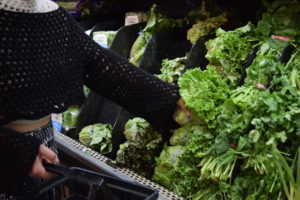By Olivia Monforte
Maya Allaire’s bank account was almost as empty as her aching stomach when she walked into the Market in the University Union. She grabbed the cheapest snacks she could find – Donettes and Pringles – and headed to the register. There was nothing nutritious about the meal, but it was what she felt she could afford.
“I’ve kind of just been starving myself the last couple of months – not having enough money to buy decent food,” said the environmental earth and soil science senior. “When I do buy food, it’s because I’m so hungry and I have to go to the Campus Market because it’s the only thing I can get to.”
In January, a friend told Allaire about a government program that helps students access healthy food. So she applied for CalFresh, a state-run food assistance program for low-income Californians. That was the beginning of a three month bureaucratic journey.
CalFresh is the California branch of a government funded program called SNAP, or the Supplemental Nutrition Assistance Program, also known as food stamps. There are 58 counties in California, and SLO County has the second lowest CalFresh enrollment rate in the state.
Less than half of eligible individuals in SLO county are receiving benefits. However, it’s not for lack of outreach effort by on-campus and community officials.
Throughout the 2022-2023 school year, Cal Poly CalFresh Outreach team has launched social media campaigns and partnerships with campus groups like CP Scholars to promote the program. Once students are aware of the program, volunteers on the outreach team help students with the application process.
The efforts to increase enrollment and diminish stigma have had some success. Last academic year, the outreach team helped 1,600 students complete the application, according to program coordinator Aydin Nazmi.

The CalFresh application is challenging, according to Allaire. Unaware of the help available to her, she struggled to get through the process on her own.
“I called at least once or twice a week for months, left so many messages asking about the status of my application – when I was actually going to be able to access EBT,” Allaire said. “I need money for food and I’ve been needing it for a while. I just never heard anything back or I couldn’t even leave a message sometimes.”
Eventually, she said, her caseworker called her back. She told Allaire that she did not submit the right pay stubs and that she only had until the end of the day to resubmit them or her application would be voided.
Luckily, a friend who already had EBT was able to help her find the pay stubs. More than three months after she submitted her application, she was finally able to access her benefits. Allaire is grateful for her fully stocked fridge, but she said she would not have made it through the application on her own.

How do students know if they are eligible?
Until recently, the CalFresh benefit program had been mostly inaccessible for students, according to Lucy Rodriguez, the CalFresh outreach manager for Cal Poly students. Strict guidelines were required to qualify as a part of a Local Program that Increases Employability (LPIE). However, state legislators passed a bill (AB 396) in October 2021 that loosened these guidelines.
Now, any major or academic program that requires an internship, work training, resume building, or a lab has the potential to be approved as an LPIE, which in turn makes its students eligible for CalFresh. Cal Poly currently has 89 approved LPIEs.
In the past few years, the Cal Poly CalFresh outreach team has been working to let students in these majors know that they are eligible for CalFresh and help them through the application process. A screener on their website and Instagram helps students find out if their major qualifies as an LPIE. Around 2,000 students have used this screener since it was launched a few months ago, according to Rodriguez. But she still suggests that students get help from their team with the application process.
“There’s been improvements to this application, but at the end of the day, it is still a government application, so they use words that aren’t really familiar to people,” Rodriguez said. “Then once the student clicks submit on that application, they’re wondering what’s next.”
Rodriguez and her team have advice to prepare students for every step of the process, from the moment they consider applying until they start using their benefits. Here are some of their tips:
- Students will be assigned a caseworker who will most likely call from a blocked number. Lucy Rodriguez recommends keeping an eye out for calls and setting up a voicemail in case the call is missed.
- The EBT card which contains benefits may be mailed, or students might have to go pick it up at the Department of Social Services Office.
- The whole process takes at least 30 days. If students don’t hear back within those 30 days, they are encouraged to reach out to the CalFresh outreach team who will help investigate the holdup.
What are other resources available to students?
Another group working to increase CalFresh enrollment among students is the SLO Food Bank, which works closely with CalFresh to fight food insecurity in the county.
Venessa Rodriguez is the CalFresh outreach manager for the SLO Food Bank. Her position was created in 2021 to increase communications between the food bank and SLO county about CalFresh. There is a lot of confusion about the relationship between the food bank and CalFresh, she said.
“CalFresh is a federal program but the SLO Food Bank has an interest in helping promote and bring awareness to the program,” Rodriguez said.
The more people who use CalFresh as a longer-term solution, the more resources the food bank can have available for emergency situations, according to Rodriguez.
“I think the misconception is people think that because they’re receiving CalFresh, they can’t go to the SLO Food Bank or any of our agency partners who have other food pantries,” Venessa Rodriguez said. “That’s not the case at all. You can use both programs in tandem with each other.”
The food bank distributes groceries on Mott lawn every fourth Tuesday of the month. It also helps supply the Cal Poly Food Pantry, which is located on the bottom floor of the health center. Both of these resources are free to students.
The campus food pantry was a lifeline for Mia Lew, who struggled to buy quality food once they were no longer on a campus dining plan. Lew found out about CalFresh benefits through the Disability Rights Center, which offered them long term relief rather than relying on emergency food runs.
“It gave me the opportunity to be able to actually buy food that was better for me and not just ramen and mac and cheese and processed stuff,” said the graphic communications alum, who graduated in Winter 2023.
Lew said the process was relatively seamless. About three weeks after submitting their application, they began receiving their benefits of around $250 a month.

How and where can students use benefits?
Through CalFresh, a single person household can be awarded a maximum of $281 a month to purchase groceries. These benefits roll over to the next month if they are not used completely. CalFresh benefits are accepted at any grocery store in SLO County and the Downtown SLO farmers market. At grocery stores, the EBT card can be used like any other debit or credit card. At the farmers market, the Downtown Association helps people with CalFresh get tokens, like poker chips, to pay for their produce.
“I would definitely recommend it to every single person I know because it’s so helpful and beneficial, especially to (people) that are food insecure,” Lew said. “Just keep calling your agent and asking if there’s an update or asking them to help you more, because I know some people who have had to.”
What obstacles should students be aware of after the application?
Civil engineering grad student Hailey Preston had no issue getting in contact with her agent after submitting her Calfresh application early this school year. It was the contents of her followup call that gave her trouble. She was asked to prove her status as a student and her current and past employment. The case worker also asked for tax information from the past three years and an evaluation of her car.
“It became so much of a headache that I just kind of stopped,” Preston said. “This is going to take me hours that I could just be trying to get more hours at work. I could just be going to places like the food pantry and get my pasta and milk.”

Sometimes balancing four or five classes and one or two jobs, Cal Poly students are already running on overdrive. Having the motivation to plead their case over and over again is hard, especially when students might feel ashamed to need the help in the first place.
“When you’re first starting as a student, especially with lower income students, there’s already this impostor syndrome,” Rodriguez said. “So to be struggling in school and to be worrying about your next meal, that shouldn’t be something that you have to be worrying about. There’s programs that are here to help you. So use them.”
One of the biggest deterrents for students to receive CalFresh is the need for constant follow-up on the application, according to Venessa Rodriguez.
“A lot of the time, this is the first time that students are having to be their own self advocate,” Rodriguez said. “There’s also the barriers of people having the time to actually be on their case, make sure they’re keeping up with their caseworkers, making sure that they’re turning in all the documents that they need to.”
How can students combat the stigma?
There are technology barriers that bar access for people living in rural areas, Rodriguez said. But for students, it mostly comes down to stigma and follow through.
“There’s a lot of stigma just in general – that’s not specific to our county,” Rodriguez said. “It’s just the stigma of being on welfare, relying on the system, taking benefits from other people, even though that’s not the case at all.”

Community is a powerful tool to combat the isolation of food insecurity.
“You don’t know what your friends or classmates are going through behind closed doors,” Rodriguez said.
She encouraged students to start the conversation about food insecurity and share the resources they know of.
“The conversation is normal,” Rodriguez said. “Being a hungry college student shouldn’t be normal.”






